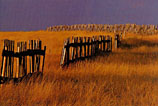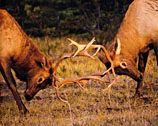
A L B E R T A
prairie to peaks
INTRODUCTION
Alberta has a varied landscape spread over an area of 661,188 sq. km. Elevations range between 200 m. above sea level, at the lowest point on the plains, and 3,747 m. at the peak of Mt. Columbia, the highest point in Alberta. Typical land forms in the province include flat prairie, rolling hills, alpine slopes, canyons, mountain peaks, and glaciers. Vegetation on these land forms includes everything from grassland, forest and muskeg, to alpine meadows and rocky outcrops. As you would expect, the diverse terrain brings about a varied climate, from summer heat on the prairies to perpetual cold on the high peaks. The major rivers in the province begin in the snow and ice of the Rockies, and flow either into the Arctic Ocean, or into Hudson Bay and the Atlantic Ocean. The Milk River, along the southern border of the province, flows into the Missouri River and eventually into the Gulf of Mexico.
Settlement by European farmers and ranchers began in the late 1800’s, mostly British, but many immigrants of other nationalities as well. The province still has a lot of farm and ranch land, but is now also one of the most energy-rich provinces.

Alberta is a land of natural spaces; vast forests, pristine lakes, wide prairies, and the magnificent Rocky Mountains. Although there are many spectacular mountain views and beautiful places that are easily accessible, there are still large tracts of wilderness where humans are almost insignificant; wild places, reached only on foot, where human impact has been minimal. If at all possible, visit in the "off season", when there are fewer buses, fewer tourists, and many more places to be explored in quiet solitude.
Over the last four years I have made many trips around Alberta, each lasting between 5 and 15 days. Each of these journeys has taken me at least 4,000 km., over 100,000 km. in total, including travel to each of the four borders of the province several times. These excursions have been in all seasons of the year and in all weather conditions.
During most of my travels around Alberta I more or less lived out of my truck. I find it much easier to be where I need to be, when I should be, if I’m already there. To get an early morning shot, for instance, I would park somewhere nearby – in a campground or at a rest stop – sleep in the back of the truck, and not have to drive any great distance in the morning. A mattress and sleeping bag were all I needed. This didn’t always work in my best interest. On one occasion, along a deserted mountain road, a bear came to visit in the middle of the night. He wasn’t easily discouraged, even when I pounded on the side of the truck with my boot. He finally left but returned twice more before morning.

Unlike my first two books, which covered the prairie only, this book tries to capture the character of the whole province of Alberta, including the majestic mountains along the western border. This required a little more effort on my part, as I don’t find it as easy to capture good mountain images as I do good prairie images. There are so many books on the market with great mountain photography in them that I felt anything I did in the Rockies had to be special and unique. I feel that I have achieved my goal. I hope you agree.
The production of this book has been a lot more work and has required significantly more travel than "it’s just PRAIRIE" or "it’s just PRAIRIE TOO". As with those books, however, the work has been a labour of love, and very satisfying.
During my travels I took over 10,000 photographs, selecting about 400 of them for possible use in the book. From those 400, with help from friends and relatives, I chose the final 136 transparencies. All of the photos in the book are considered "Foundview" images, which means:
1) Nothing has been added to or subtracted from the image after the shutter was released and
2) Nothing has been done to alter the image, either before or after the shutter was released, that would make the viewer feel that he or she had been deceived.

I believe that the best time for most photography is early morning or late afternoon. The light is better for most landscapes, the wildlife is generally active, and it’s just a nicer time of day to be out. Because there are only a few of those hours each day, and no one can guarantee suitable conditions at any time, a particular photo often requires a return trip – or two, or three! In fact, no matter how many times one returns to a specific location or wildlife area, something will always be different. You won’t always get the photograph you were looking for, but isn’t the attempt half the fun?
Finally, I would like to say a few words about the wilderness that I love. Nature is fragile! We have become accustomed to having so many conveniences in our everyday lives that we don’t stop to realize what the cost of these little extras is to the environment. Did you know that approximately 90% of the world’s resources are used by only 10% of the world’s population? We need to take better care of our planet. We can not continue to ask more of Mother Nature than she is able to give. We are already being affected directly (consider smog alerts and UV warnings), but our children and our grandchildren will feel much greater repercussions.
My hope is that this book will become an information source; an incentive for you to get out, find your own memories and become more aware of your environment. Please, have fun and enjoy!

BOOK JACKET
The photographs here represent only a very small portion of the total number of exposures I made over the past four years. I hope the ones I chose are ones that excite you as much as they did me.
Sometimes a good photo comes naturally but other times it involves a great deal of effort. Either way I always get a lot of enjoyment out of making them.
![]() For those of you interested in the technical side of my work; I use Minolta 35 mm cameras with lenses of several different focal lengths from 28 mm to 400 mm. The only filters I use on a regular basis are UV and Polarizing filters. I very rarely use a flash, preferring natural light, and therefore almost always use a tripod. Above all, none of the photographs in the book has been manipulated either digitally or in the dark room. All images are considered to be "Foundview Images".
For those of you interested in the technical side of my work; I use Minolta 35 mm cameras with lenses of several different focal lengths from 28 mm to 400 mm. The only filters I use on a regular basis are UV and Polarizing filters. I very rarely use a flash, preferring natural light, and therefore almost always use a tripod. Above all, none of the photographs in the book has been manipulated either digitally or in the dark room. All images are considered to be "Foundview Images".